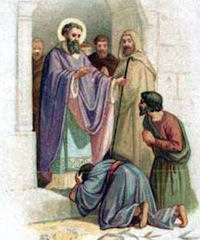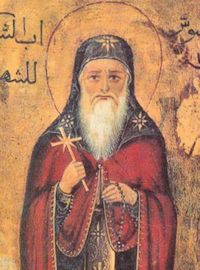Easter: May 9th
Tuesday of the Fourth Week of Easter
Other Commemorations: St. Pachomius, Abbot (RM)
» Enjoy our Liturgical Seasons series of e-books!
"I tell you most solemnly, it was not Moses who gave you bread from heaven, it is my Father who gives you the bread from heaven, the true bread; for the bread of God is that which comes down from heaven and gives life to the world." "Sir," they said "give us that bread always." Jesus answered: "I am the bread of life. He who comes to me will never be hungry; he who believes in me will never thirst (John 6:32-35)."
Before the reform of the General Roman Calendar today was the feast of St. Gregory Nazianzen. He was born in Cappadocia and pursued advanced studies in Athens at the same time as St. Basil with whom he always remained on terms of devoted friendship. From being brother students they became companions in the monastic life and then in the episcopate. St. Gregory, at first Bishop of Nazianzus and them of Constantinople, occupied the imperial see at a very troubled period. He resigned his office for the sake of peace. On his return to Nazianzus he devoted his whole time to contemplation and to the composition of theological works. So felicitously did he express the theology of the Three Divine Persons that the Greeks call him "the Theologian." He died about the year 389 and is one of the Doctors of the Church.
St. Pachomius
 St. Pachomius can justifiably be called the founder of cenobitic monasticism (monks who live in community). Even though St. Antony the Great was the first to go into the desert to live a life of seclusion pursuing evangelical perfection, he lived an eremitic life, that is, a primarily solitary life.
St. Pachomius can justifiably be called the founder of cenobitic monasticism (monks who live in community). Even though St. Antony the Great was the first to go into the desert to live a life of seclusion pursuing evangelical perfection, he lived an eremitic life, that is, a primarily solitary life.
Pachomius first started out as a hermit in the desert like many of the other men and women / in the third and fourth centuries who sought the most radical expression of Christian life and he developed a very strong bond of friendship with the hermit Palemon. One day he had a vision during prayer in which he was called to build a monastery, and was told in the vision that many people who are eager to live an ascetic life in the desert, but are not inclined to the solitude of the hermit, will come and join him. His hermit friend Palemon helped him to build the monastery and Pachomius insisted that his cenobites were to aspire to the austerity of the hermits.
However, he knew that his idea was a radical one, in that most of the men who came to live in his monastery had only ever conceived of the eremitic lifestyle; his great accomplishment was to reconcile this desire for austere perfection with an openness to fulfilling the mundane requirements of community life as an expression of Christian love and service. He spent most of his first years as a cenobitic doing all the menial work on his own, knowing that his brother monks needed to be gently inducted into serving their brothers in the same manner. He therefore allowed them to devote all their time to spiritual exercises in those first years. At his death, there were eleven Pachomian monasteries, nine for men and two for women.
The rule that Pachomius drew up was said to have been dictated to him by an angel, and it is this rule that both St. Benedict in the west and St. Basil in the east drew upon to develop their better known rules of cenobitic life.
— Catholic News Agency
Highlights and Things to Do:
- Read more about St. Pachomius:
- St. Pachomius is considered to be the father of cenobitic monasticism. What does cenobitic even mean? The first type monastic living was the life of a hermit, living solitarily, called eremitic. Cenobitic monasticism emphasizes community life. In Western monasticism the cenobitic monks join in a community of a religious order, regulated by a religious rule, a collection of precepts. St. Augustine and St. Benedict followed the example set by Pachomius for their religious orders.






